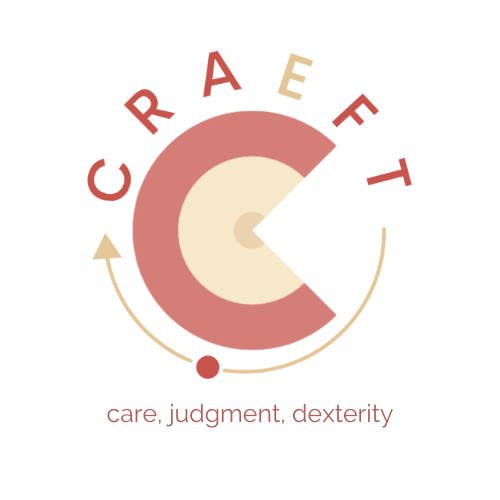Objectives
To validate the generality and expressiveness of the approach, Craeft pilots will cover a range of RCIs and compare them across similar techniques and materials. The pilots share three common goals:
- Preservation of crafts for posterity.
- Digital preservation in international and open standards for digital libraries.
- Education & training curricula for the future that reflect on the tradition and foster intellectual and technical innovation
- increase the value of education & training programmes appropriating technical aids per craft requirements
- reduce training & experimentation costs
- reduce the distance between instructors and students
- acknowledge training & document personal skills and contributions to the state of the craft.
- Informal training from traditional practitioners, with remote tutoring capabilities, educational material and activities for introductory workshops.
- Reduction of material & energy waste
- efficient workflows
- reduction of resource consumption in training
- education on refurbishment and re-manufacture
- new designs that reuse parts for a circular economy.
- Development of design skills for new products
- learn from traditional techniques
- re-usability inventories of designs & techniques in contemporary products
- reduce the cost of experimentation
- iterative planning and digitization to carefully plan the next step and reduce risk
- physical toys
- digital games.
Pilot themes
Pilot #1. Education & Training
Objective Catalyse continuation of practice through craft education, training, and awareness.
Curricula:
- Glassblowing CERFAV, Vocational Training Certificate
- Porcelain pottery ENSA-Limoges
- Aubusson tapestry Villa Châteaufavier & ENSA-Limoges
- Marble crafts,Preparatory & Professional School of Fine Arts of Panormos
- Silversmithing,Centre of Traditional Crafts of Ioannina
- Woodcarving CETEMindustrial training, geragogy
- Clay pottery Kerameion, experimental archaeology pottery workshops
- Traditional textiles,Women Entrepreneurs Association of Crete, informal learning in duals.
Pilot #2. Design
Objective Revive traditional techniques and develop novel designs and fabrication possibilities.
Method:
- Craft-specific digital design & fabrication aids, co-designed with craft masters, designers, and curators to acquire insight from and meaningfully assist the •
- Exploration of new designs according to material and technique •
- Inventorisation with traditional and new designs & styles to aid contemporary product making •
- Exploration of new materials & fabrication possibilities • Recovery and reenactment of lost techniques •
- Preview the result with realism and preview its appearance in the real environment, of the customer •
- Design new products fusing techniques and material in contemporary utilitarian items.
Pilot #3. Valorisation
Objective: practice continuation supported by diversification of income streams
Methods:
- Tutoring and technical assistance facilitate learning from practitioners in highly specific locations or remote to apprentices. The professional network of MDE will utilise digital aids to invite apprentices to their workshops or visit student workspaces for technical assistance and tutoring. Also, the preparation of educational onsite/hybrid workshops coupling introductory crafting experiences with thematic and cultural tourism.
- Accompanying digital online • content in multiple storytelling formats: podcast, electronic print, multimedia storytelling, interactive & immersive experiences, themed on: ICH dimensions, Art & History, local tradition, materials, biographical objects, personalised gifts • services (games, webinars).
- Certification of purchase, creator signage, collective/certification marks, composition, origin, production method, linkage to “green” certificates.
- Reduce material waste by designing efficient workflows in Craft Studio, reusing spare and old material parts, and authoring repair instructions.
- Create digital games&physical toys, using the Apprentice Design Studio, respectively.
- Seize valorisation opportunities through tutoring services, marketing digital assets & designs, fabrication services, and consultation.
- Promotion of products and local culture, through realistic online previews, contextualisation content, and guides to craft-related thematic tourism destinations.
Pilot #4. Community
Objective Create added value and enhance the preservation and sustainability of European crafts through a Community Portal to act as a one-stop-shop for education, training, craft design and innovation in Europe.
Methods:
- Deploy aCommunity Portal for the creative exchange between stakeholders building on existing communities and networks reinforced with new members through the strong communication activities of the project
- Build the community identity early in the project by involving practitioners providing insights, instructions, interviews, demonstration of techniques & designs, share educational & training material, interviews with instructors and master classes
- Disseminate results, content experiences from all pilots and pilot sites and form individual craftsperson and micro businesses through experiential presentations, educational and training services and realistic 3D presentation of craft artefacts
- Support entrepreneurship to increase practitioner income streams through new products and services by reaching out and involving business stakeholders, customers, end users and learners
- Host tenders for creative designs and communicate funding opportunities with craft communities
- Incentivise building practitioner reputation through means of community status and recognition
- Perform user-based evaluation of [1-6] to assess the usability, user experience and impact of the community to crafts community and with regards to the objectives of the project
